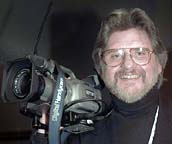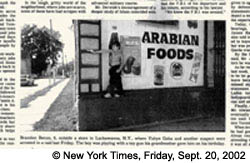A few months ago, NY Times photographer Eddie Keating was covering a story in Lackawanna County, New York. Six Arab-Americans had been arrested on charges they had attended an Al Queda training camp.
According to Keating, as he started across the street to the suspect's house, the boy tagged along. Worried about taking him across the street, Eddie asked the parents if it was all right for him to come along. They said it was fine. On the porch of the suspect's house, Eddie was taking pictures, and the boy darted in and out, with his toy gun. Eddie took his picture. As he left the house, a photographer from the Buffalo News came up to him, and told him he had taken some nice pictures of Eddie at work. In the following days, the picture editors at the Times began to hear rumors that photographers were talking about Eddie setting up a picture. Since it was only a rumor, they didn't put much credence in it. Amazingly, a few days later, the Times ran Eddie's picture of the boy on the porch of the suspect's house playing with his gun. Subsequently, the Columbia Journalism Review picked up the story. The Times editors finally woke up to what was going on, and they called Eddie in. Since then, his life has been hell. The National Press Photographer's list has been full of invective about "the staging of a photograph." So, what went wrong? First, I have to tell you that Eddie Keating is one of the most ethical photographers in the business. He attended a Platypus Workshop several years ago, and during the class when we were discussing the ethics of the necessity of obtaining sequences, he was outspoken. On this day, Eddie suffered severe judgment lapses. First, he should never have taken a picture of the boy outside of the environment in which he found him. By allowing the child to follow him to what was essentially a crime scene, he was transporting him into another environment. The fact that he asked the parents' permission to take the child across the street in this case made him a culpable party. When the photographer from the Buffalo News told him he had taken his picture, every warning bell should have been sounding in Eddie's head. At that point, he should have trashed the pictures. Even more important, once the Times picture editors had been alerted to a potential problem they should never had run the picture in the paper. The final offending act in the saga was the publication of the picture. In Eddie's mind, the whole episode was very innocent. He was befriending a child who wanted to see him at work. When asked about the picture by the Times picture editors in the days following the episode, he told them what had happened, and they told him it was no problem. At the end of the day there were serious misjudgments not only by Eddie, but also the Times editors who went ahead and ran the picture.The moral from this story is how easy it is to start to slide down the slippery slope that results in the crime of "setting up a picture." © Dirck Halstead |
|
|
Write a Letter
to the Editor |

 When
Eddie and a reporter from the Times arrived in the neighborhood where
the suspects lived, they started interviewing neighbors. Across the
street from the house in which the suspects had lived, they interviewed
a family. Six-year-old Brandon Benzo was playing with a toy gun, and
while the reporter was doing the interview, Eddie started to shoot pictures
of the boy.
When
Eddie and a reporter from the Times arrived in the neighborhood where
the suspects lived, they started interviewing neighbors. Across the
street from the house in which the suspects had lived, they interviewed
a family. Six-year-old Brandon Benzo was playing with a toy gun, and
while the reporter was doing the interview, Eddie started to shoot pictures
of the boy.